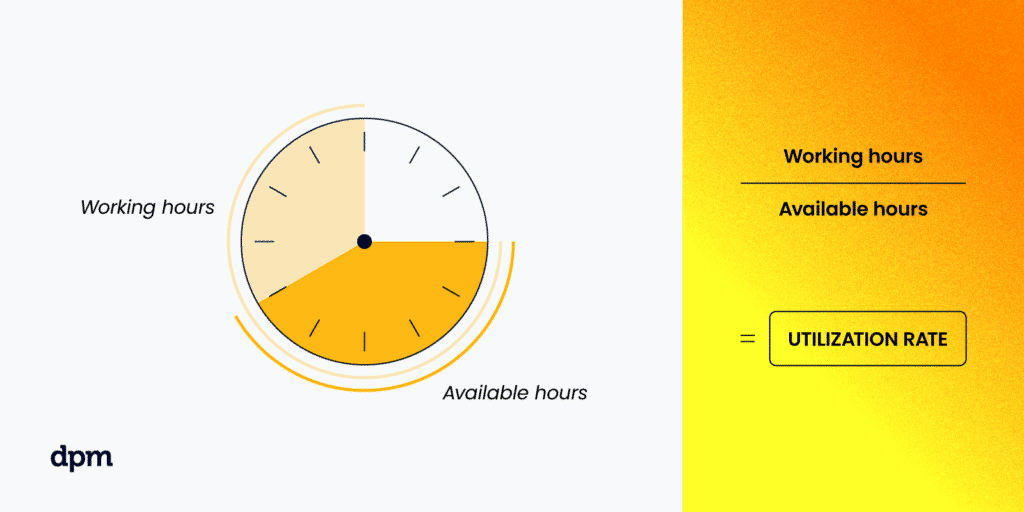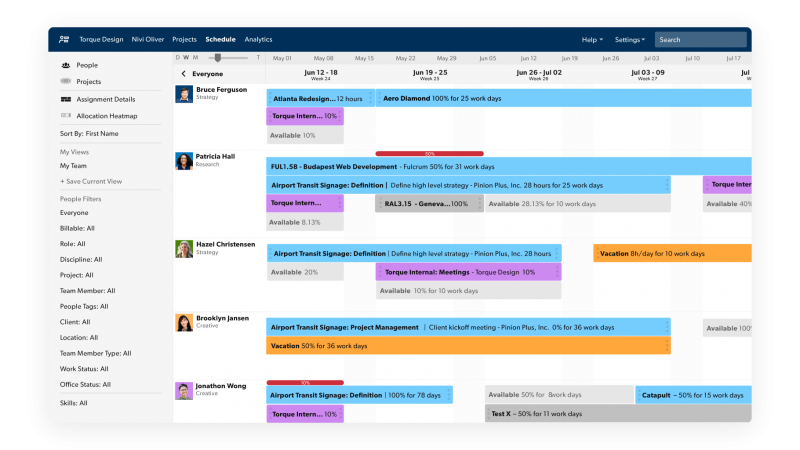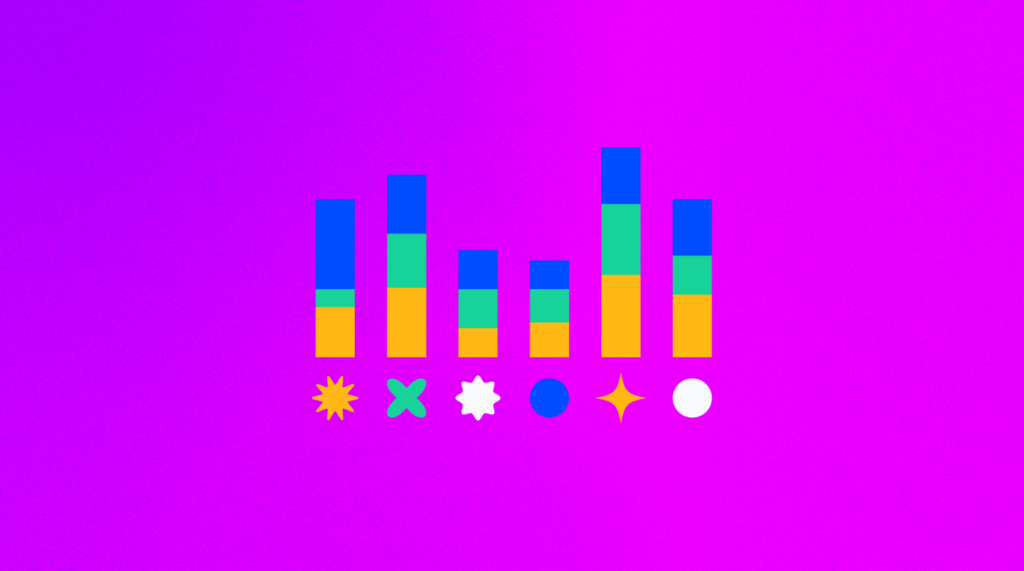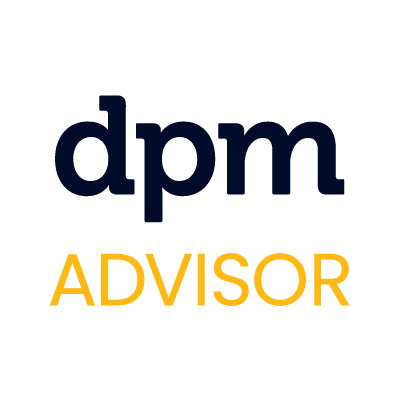In the hustle and bustle of day-to-day project activity, it’s easy to get lost in the details and forget to consider the big picture. Resource utilization metrics can be an important tool for managing project resources and monitoring project and portfolio health.
What Is Resource Management?
Project resource management is a key part of a project manager’s responsibilities. It involves planning, assembling, and managing the team members and supplies needed to complete project work. To manage project resources effectively, you’ll need to consider resource availability, resource allocation, and resource management. Think of these key terms as follows:
- Resource availability: the amount of time people have to contribute to a project, in theory
- Resource allocation: how much time people are spending on project work, in reality
- Resource management: the optimization of allocated resources during a project.
Key Resource Utilization Metrics
Project managers analyze resource utilization metrics to understand which resources are used, how they’re used, and whether their application is appropriate. The goal is to identify inefficient resource uses and then develop a strategy to improve resource utilization.
But which performance metrics are the most important to track? Below is a list of key resource utilization metrics that could be a good starting point for consideration. They are useful in determining whether resources are being used optimally.
Keep in mind this list is not comprehensive. You might find there are other metrics or strategies that are more useful for your projects, teams, and company.
1. Resource Utilization
This is a breakdown and analysis of a team member’s available hours and how much time they spend on each project. It is also known as the billable utilization rate.
The easiest way to determine your utilization rate is to use the following formula:
Working hours / Available hours = Utilization rate

Utilization rate is based on a team member’s time spent on a project versus how much time they have assigned for it. You can think of it as billable hours versus available. Here’s an example:
36 working hours / 40 available hours = 90 percent team member utilization rate
2. Ramp Speed
Ramp speed measures the time it takes for a team member to reach their desired resource utilization rate. If ramp speed is too slow, the team member might require additional training or support. It could also signal a need to improve your onboarding process for future new hires.
3. Effort Variance
Effort variance measures projected hours and hours worked. It can be calculated per resource, project, or department. This metric is useful for determining how many hours are needed for a project. The trends surfaced from this data can help guide managers in project planning.
4. Cost Variance
Cost variance provides budgetary insights. Project managers calculate cost variance by comparing actual expenditures with estimated costs. This metric indicates whether projects are on budget and how they can impact earnings.
SMART Goals and Resource Utilization Metrics
As project managers track resource utilization metrics, it’s important to set and achieve goals related to these metrics.
Setting goals and benchmarks will help ensure that resources are used efficiently and that budget and time are being spent accordingly. Each goal should be specific, measurable, achievable, realistic, and time bound—hence the SMART acronym.
Specific
Team members can’t achieve a goal unless it’s clearly defined. Who is involved, what are they trying to accomplish, when must they accomplish it, which obstacles and/or requirements will hinder progress, and why must they accomplish this goal?
Measurable
What is the measure of success? There’s no single definition that answers this question, and it varies by project. Consider the goal and what success looks like. Data such as revenue, automated reports, surveys, and work products are useful success indicators.
Achievable
How important is the goal, and how can it be accomplished? Does the team have the required tools and abilities to accomplish it? If not, what can be done to support the team?
Relevant
How do the project and goals fit with the rest of the company’s goals? Both should be clearly aligned with the company.
Time Bound
What is the goal’s deadline? What will progress look like at the halfway point?
SMART Goal Example
An example may help distinguish a SMART goal from, uh, a less smart one.
Example: Sarah will publish 18 pieces of creative content for her personal website by the end of Q3 2022 to increase her monthly site readership by 10%.
To achieve this goal, she will allocate 4 hours a week to content creation, first thing in the morning on Saturdays and Sundays, to reduce the risk of distraction.
This goal is important because it supports her desire to increase the amount of time spent on creative pursuits to improve her emotional well-being.
This goal is SMART because it is quantifiable, with an assigned deadline. The goal also includes context about its relative importance and alignment with broader objectives.
Find out more about creative resource management here.
The Importance of Resource Utilization Metrics
Resource utilization metrics are important indicators of project health and also help ensure proper project funding and support. Imagine the following scenarios:
- Monitor Project Health. Project tasks are proceeding according to plan, but you sense that the amount of effort required to keep up with the project timeline is way too high. Resource utilization metrics help you quantify the impacts on your project’s bottom line and course correct before this problem gets out of hand. This might involve adjusting the schedule, identifying operational efficiencies, and/or substituting for lower cost resources.
- Optimize Resource Allocation Across Your Portfolio. Analyzing resource data helps determine whether managers can redistribute excess resources to other projects that might need additional help. As a project manager, you are likely familiar with your team’s skill sets and career aspirations and can help recommend appropriate assignments that increase staff motivation and, therefore, productivity and portfolio health.
- Improve Project Selection. Performance metrics are also useful in determining whether a project should be killed. Conversely, accurately applying resource utilization metrics can also justify keeping projects off the proverbial chopping block.
How to Track Resource Utilization Metrics
For small projects or departments, a project manager can keep track of resource utilization metrics using a simple Excel spreadsheet (think a list of team members with hours worked by day.)
Since updating resource utilization metrics can be time-consuming, I’d recommend establishing a reasonable cadence.
In my consulting days, I used to pull financial reports monthly to understand how many hours team members were expending on the project versus the estimates forecasted at project outset (resource management software can help with this!)
Towards the end of a project or while awaiting funding, I would increase the frequency to biweekly, weekly, or even daily so I could keep stakeholders apprised of the financial prognosis and, most importantly, avoid cost overruns.
Resource Management Software
Resource management software is an invaluable tool that project managers can use to aggregate resource data and analyze that data for optimal resource usage.
In some cases, a spreadsheet can work (like this one for tracking resource allocation), but for more complicated projects requiring more resources, you’ll likely want a dedicated resource management software.
Resource Management Software Features

When selecting the appropriate resource management software for your organization, be sure to evaluate whether the software includes these salient features:
- Visualization of resource availability and resource allocation across team members
- Resource scheduling
- Integration with timesheet software
- Automated resource allocation based on parameters that you specify
- Alerts when there are unexpected changes in performance metrics
- Ability to set different permissions across user groups.
Which Resource Management Software Is the Best?
It’s hard to define which resource management software is best—it depends on many factors, such as project goals, the size of your organization, and the nature of your business.
Learn more about how to choose resource management software based on your specific needs, and get our list of the best options available on the market right now.
Or, learn how to choose the right resource software for your needs here.
Other Types of Software
You can pair resource management software with other types of software to make it easier to track and complete a variety of tasks. Examples include project scheduling software, marketing resource management software, resource tracking software, and project management software.
While some might view software as the only solution to tracking resource utilization, it’s also true that spreadsheets and databases can accomplish these tasks.
The difference is a matter of cost and time. You might be able to accomplish this challenge on your own, but it will inevitably eat into your available hours.
Need expert help selecting the right Project Resource Management Software?
If you’re struggling to choose the right software, let us help you. Just share your needs in the form below and you’ll get free access to our dedicated software advisors who match and connect you with the best vendors for your needs.
Managing a Metric Ton of Data
Resource utilization metrics require constant attention, but the insights they provide protect team members, resources, and projects from waste.
These metrics also help guide projects from inception to completion and beyond. Metrics are a necessity in today’s rapidly changing, technology-driven landscape.
For more help regarding resource utilization metrics, project resource management best practices, or other digital project management topics, subscribe to The Digital Project Manager newsletter.



